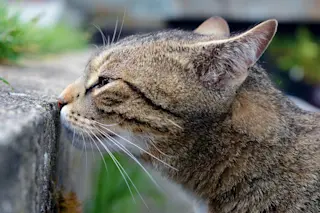The gas chromatograph, a ubiquitous scientific instrument used to separate and analyze different gasses, could learn a great deal from the cat’s nose, a new study says. As the first detailed study of the feline sniffer, it reveals a dual-channel system in the nose that the instrument could perhaps replicate.
“We know so much about vision and hearing, but not so much about the nose. This work could lead to more understanding of the evolutionary pathways behind different nose structures, and the functional purpose they serve,” says Kai Zhao, an associate professor of otolaryngology in Ohio State’s College of Medicine, in a press release.
The channel system serves as major highways on a complex road system. A cat inhales air into its nose, flooding both, and they in turn infuse a labyrinth of small passages called turbinates that clean and humidify the air. The turbinates pass the air on to ...














